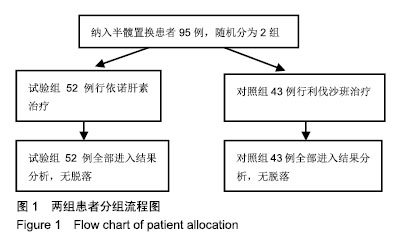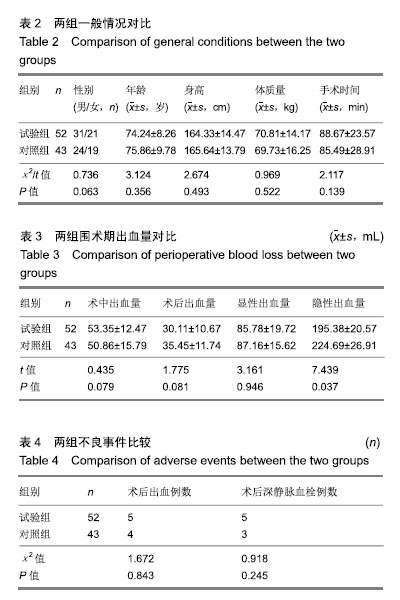| [1]Kristensen TB, Vinje T, Havelin LI, et al. Posterior approach compared to direct lateral approach resulted in better patient-reported outcome after hemiarthroplasty for femoral neck fracture: 20,908 patients from the Norwegian Hip Fracture Register. Actaorthopaedica. 2017; 88(1): 29-34.[2]Berggren M, Stenvall M, Englund U, et al. Co-morbidities, complications and causes of death among people with femoral neck fracture-a three-year follow-up study. BMC Geriatr. 2016;16(1): 120.[3]Tabori-Jensen S, Hansen TB, Bøvling S, et al. Good function and high patient satisfaction at mean 2.8 years after dual mobility THA following femoral neck fracture: a cross-sectional study of 124 patients. Clin Interv Aging. 2018;13:615-621.[4]Olofsson B, Persson M, Bellelli G, et al. Development of dementia in patients with femoral neck fracture who experience postoperative delirium-A three-year follow-up study. Int J Geriatr Psychiatry. 2018; 33(4):623-632.[5]中华医学会骨科学分会.中国骨科大手术静脉血栓栓塞症预防指南[J].中华骨科杂志,2009,29(6):602-604.[6]中华医学会骨科学分会.中国骨科大手术静脉血栓栓塞症预防指南(2016年修订) [J].中华骨科杂志,2016,36(2):65-71.[7]Hailer NP, Garland A, Rogmark C, et al. Early mortality and morbidity after total hip arthroplasty in patients with femoral neck fracture: A nationwide study of 24,699 cases and 118,518 matched controls. Actaorthopaedica. 2016;87(6):560-566.[8]Ikesaka RT, Kahn SR, Galanaud JP, et al. The importance of post thrombotic syndrome as an outcome after deep venous thrombosis: A survey of Canadian thrombosis clinicians. Thromb Res. 2017;159: 13-15.[9]Aviña-Zubieta JA, Bhole VM, Amiri N, et al. The risk of deep venous thrombosis and pulmonary embolism in giant cell arteritis: a general population-based study. Ann Rheum Dis. 2016;75(1):148-154.[10]Suarez L, Tangney E, O'Donnell TF, et al. Cost analysis and implications of routine deep venous thrombosis duplex ultrasound scanning after endovenous ablation. J Vasc Surg Venous Lymphat Disord. 2017;5(1):126-133.[11]López JM, Fortuny G, Puigjaner D, et al. Effects of walking in deep venous thrombosis: a new integrated solid and fluid mechanics model. Int J Numer Method Biomed Eng. 2017;33(5). doi: 10.1002/cnm.2819. [12]Pannucci CJ, MacDonald JK, Ariyan S, et al. Benefits and risks of prophylaxis for deep venous thrombosis and pulmonary embolus in plastic surgery: a systematic review and meta-analysis of controlled trials and consensus conference. Plastic Reconstr Surg. 2016; 137(2): 709-730.[13]Missirlis D, Haraszti T, Kessler H, et al. Fibronectin promotes directional persistence in fibroblast migration through interactions with both its cell-binding and heparin-binding domains. Sci Rep. 2017;7(1): 3711.[14]Mulloy B, Hogwood J, Gray E, et al. Pharmacology of heparin and related drugs. Pharmacol Rev. 2016;68(1): 76-141.[15]Abreu R, Essler L, Loy A, et al. Heparin inhibits intracellular Mycobacterium tuberculosis bacterial replication by reducing iron levels in human macrophages Sci Rep. 2018;8(1): 7296.Ezekwudo DE, Chacko R, Gbadamosi B, et al. Apixaban for treatment of confirmed heparin-induced thrombocytopenia: a case report and review of literature. Exp Hematol Oncol. 2017;6(1): 21.[17]Schurr JW, Stevens CA, Bane A, et al. Description and evaluation of the implementation of a weight-based, nurse-driven heparin nomogram in a tertiary academic medical center. Clin Appl Thromb Hemost. 2018;24(2): 248-253.[18]Sepuru KM, Iwahara J, Rajarathnam K. Direct detection of lysine side chain NH 3+ in protein-heparin complexes using NMR spectroscopy. Analyst. 2018;143(3):635-638.[19]Hata Y, Iwasaki M, Fujitaka K, et al. Heparin induces the mobilization of heart-derived multipotent mesoangioblasts during cardiac surgery with cardiopulmonary bypass or cardiac catheterization. Circ J. 2018;82(5):1459-1465.[20]闫建红,李保.肝素诱导血小板减少症的新进展[J].临床医药实践, 2016, 253(2):128-132.[21]Laube ES, Mantha S, Samedy P, et al. Treatment of central venous catheter-associated deep venous thrombosis in cancer patients with rivaroxaban. Am J Hematol. 2017;92(1):E9.[22]Weitz JI, Awa L, Prins MH, et al. Rivaroxaban or aspirin for extended treatment of venous thromboembolism. New Eng J Med. 2017;376(13):1211-1222.[23]Ayerst BI, Smith RAA, Nurcombe V, et al. Growth differentiation factor 5-mediated enhancement of chondrocyte phenotype is inhibited by heparin: implications for the use of heparin in the clinic and in tissue engineering applications. Tissue Eng Part A. 2017; 23(7-8): 275-292.[24]余华,何凤.彩色多普勒超声检查对早期发现下肢静脉血栓形成的临床意义[J]. 临床医学研究与实践,2017,2(22):137-138.[25]邵素臣,俞昌明.彩色多普勒超声在下肢深静脉血栓诊断中的临床应用[J]. 医学影像学杂志,2017,27(4):783-786.[26]魏俊强,王新宇,金宇,等.利伐沙班对股骨转子间骨折术后失血风险和深静脉血栓形成的效果及安全性研究[J]. 解放军医药杂志,2015, 27(10):91-93+99.[27]Kucher N, Aujesky D, Beer JH, et al. Rivaroxaban for the treatment of venous thromboembolism. The SWIss Venous Thromboembolism Registry (SWIVTER). Thromb Haemost. 2016; 116(3):472-479.[28]Erlinge D, Omerovic E, Fröbert O, et al. Bivalirudin versus heparin monotherapy in myocardial infarction. New Eng J Med. 2017; 377(12):1132-1142.[29]闫建红,李保.肝素诱导血小板减少症的新进展[J].临床医药实践,2016, 25(2):128-132.[30]赵凡,李成程. 抗凝新药利伐沙班临床研究[J]. 医学信息,2016,29(23): 231.[31]Hom L, Sobieraj DM. The impact of initiating rivaroxaban versus low- molecular weight heparin plus warfarin in patients admitted to the hospital for venous thromboembolism. Int J Cardiol. 2015;198:87-88.[32]Ohmori T, Kitamura T, Onishi H, et al. Effect of pre-injury anticoagulant and antiplatelet agents on blood loss in elderly patients with severe trauma. Acute Med Surg. 2016;3(2):114-119.[33]George J, Sikora M, Masch J, et al. Infection is not a risk factor for perioperative and postoperative blood loss and transfusion in revision total hip arthroplasty. J Arthroplasty.2017;32(1):214-219.[34]侯炜,葛京化,张霆,等.135例半髋关节置换患者的隐性失血分析[J].中国中医骨伤科杂志,2017,25(7):44-46.[35]白云飞,房体刚,孙瑞.老年全髋关节置换后利伐沙班与低分子肝素预防深静脉血栓形成及失血情况对比[J].中国组织工程研究,2018,22(15): 2303-2308.[36]Gao F, Sun W, Guo W, et al. Topical administration of tranexamic acid plus diluted-epinephrine in primary total knee arthroplasty: a randomized double-blinded controlled trial. J Arthroplasty. 2015; 30(8):1354-1358. |
.jpg)


.jpg)
.jpg)